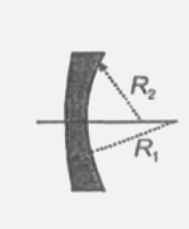The spherical surface of a plano-convex lens comes into contact with a glass plate. The space between the lens and the plate is filled up with carbon dioxide. The refractive indies of the lens, carbon dioxide, and the plate are equal to n1=1.50,n2=1.63, and n3=1.70 respectively. the curvature radius of the spherical surface of the lens is equal to R=100cm. Determine the radius of the fifth dark Newton's ring in reflected light with wavelength λ=0.50μm.
The condition for minima are
r2Rn2=(k+12)λ,
(There occur phase changes at both surfaces on reflection, hence minima when path difference is half interger multiple of λ).
In this case k=4 for the fifth dark ring
(Counting from k=0 for the first dark ring).
Thus, we can write
r=√(2K−1)λR/2n2,K=5
Substituting we get r=1.17mm.
Topper's Solved these Questions
- BOOK - IE IRODOV, LA SENA & SS KROTOVCHAPTER - OPTICSEXERCISE - Diffraction Of Light60videos
OPTICS
- BOOK - IE IRODOV, LA SENA & SS KROTOVCHAPTER - OPTICSEXERCISE - Polarization Of Light43videos
OPTICS
- BOOK - IE IRODOV, LA SENA & SS KROTOVCHAPTER - OPTICSEXERCISE - Exercise2videos
OPTICS
- BOOK - IE IRODOV, LA SENA & SS KROTOVCHAPTER - MECHANICSEXERCISE - Mechanics Problems92videos
MECHANICS
- BOOK - IE IRODOV, LA SENA & SS KROTOVCHAPTER - OSCILLATIONS AND WAVESEXERCISE - Electromagnetic Waves, Radiation36videos
OSCILLATIONS AND WAVES
Similar Questions
Knowledge Check
- Question 1 - Select One
If in a plano-convex lens, the radius curvature of the convex surface is 10 cm and the focal length of the lens is 20 cm , then the refractive index of the material of lens will be
A1.5B1.66C1.33D3 - Question 2 - Select One
If in a plano-convex lens, the radius curvature of the convex surface is 10 cm and the focal length of the lens is 30 cm, then the refractive index of the material of lens will be
A1.5B1.66C1.33D3 - Question 3 - Select One
If in a plano-convex lens, the radius of curvature of the convex surface is 10 cm and the focal length of the lens is 30 cm , then the refractive index of the material of lens will be
A1.5B1.66C1.33D3
The convex surface of a plano-convex glass lens comes into contact with a glass plate. The curvature radius of the lens's convex surface is R, the wavelength o flight is equal to λ. Find the width Δr of a Newton ring as a function of its radius r in the region where Δr<<r.
View SolutionThe convex surface of a plano-convex lens is silvered and the radius of curvature of this surface is R. Find the focal length of the system:
View SolutionFind the focal length of a plance-convex lens with R1=15cm and R2=∞. The refractive index of the lens material n=1.5
View SolutionThe convex surface of a plano-convex glass lens with curvature radius R=40cm comes into contact with a glass plate. A certain ring observed in reflected light has a radius r=2.5mm. Watching the given ring, the lens was gradually removed from the plate by a distance Δh=5.0μm. What has the radius of that ring become equal to?
View SolutionThe radius of curvature of the curved surface of a plano-convex lens is 20cm. If the refractive index of the material of the lens be 1.5, it will
View Solution


